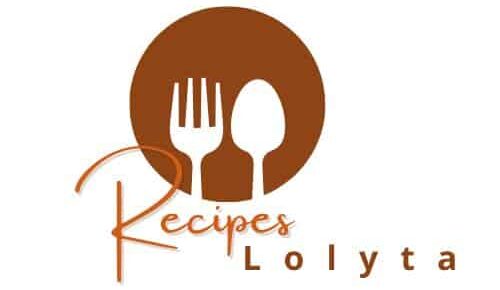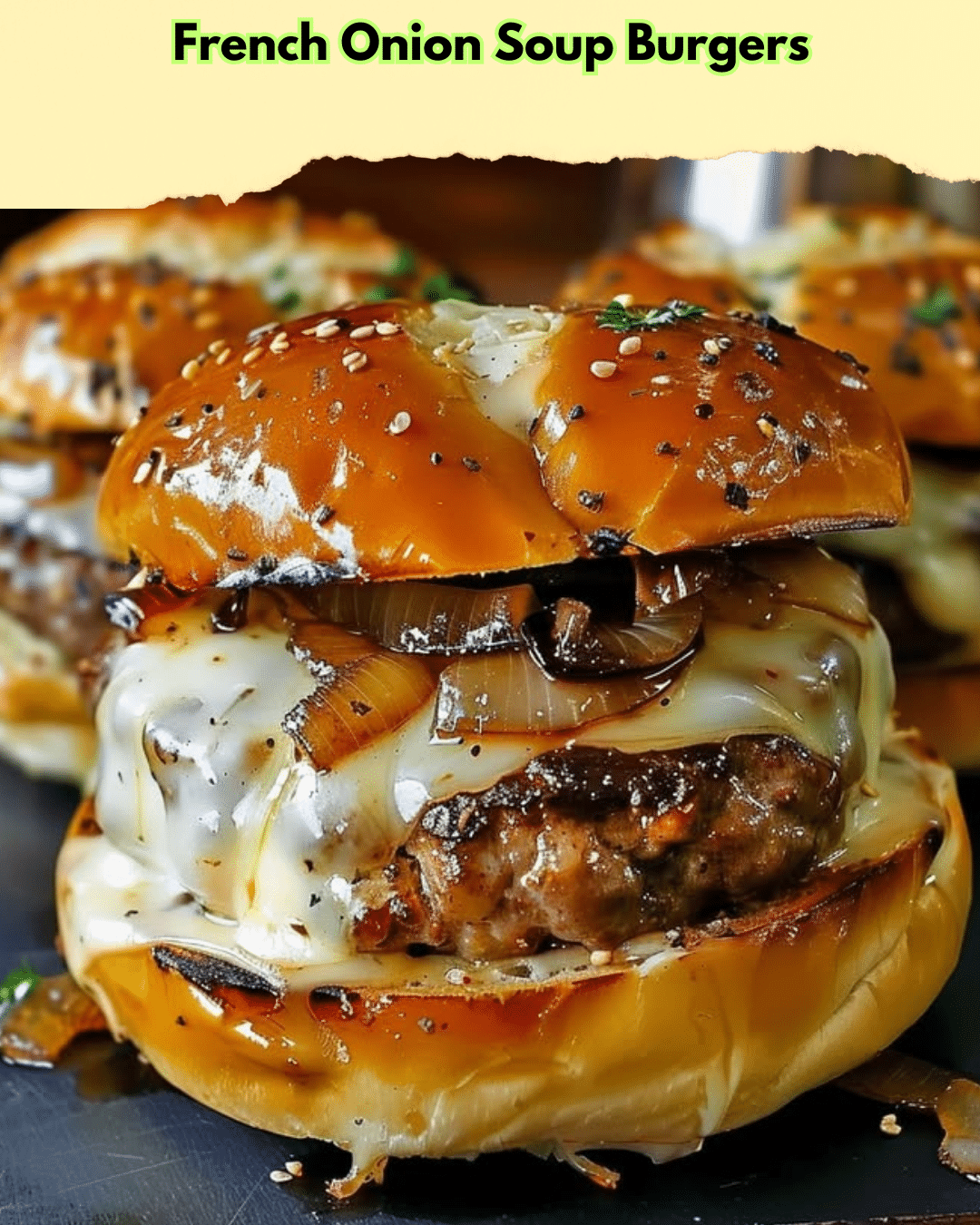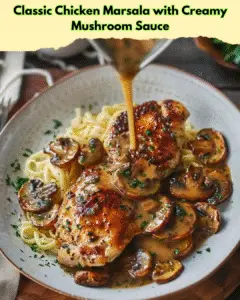French Onion Soup Burgers: A Gourmet Twist on a Classic
French Onion Soup Burgers are a delightful fusion of two classic favorites: the rich, savory flavors of French onion soup and the satisfying bite of a juicy burger. The melding of caramelized onions, gooey cheese, and perfectly seasoned beef creates an unforgettable culinary experience that appeals to both comfort food lovers and gourmet enthusiasts. Each bite promises a burst of flavors, making these burgers an ideal choice for a cozy night in or a family gathering.
Impress your guests with these French Onion Soup Burgers that deliver bold onion and beef flavors wrapped in melted cheese goodness. The caramelized onions offer a sweet and savory profile that pairs seamlessly with the hearty beef patty. As you take a bite, the rich flavors meld together, providing an irresistible combination that leaves you craving more. Crafted with love and attention, these burgers are bound to become a staple meal in your home.
Quick Recipe Highlights
- Flavor Profile: These burgers showcase a robust blend of sweet, savory, and umami flavors. The onions, beef, and cheese harmonize perfectly, delivering a gourmet burger experience.
- Texture: Experience a contrast of textures with crunchy toasted buns, succulent beef patties, and creamy melted cheese that create a satisfying mouthfeel.
- Aroma: The caramelized onions exude a warm, inviting aroma, while the beef and cheese contribute layers of rich scents that enhance the overall sensory appeal.
- Visual Appeal: With perfectly golden onions topping the burger and a luscious cheese melt, these burgers are a feast for the eyes as much as they are for the palate.
- Skill Level Needed: With medium difficulty, this recipe requires basic cooking skills such as sautéing and pressing patties, making it accessible yet rewarding for home cooks.
- Special Equipment: A skillet, spatula, and meat thermometer are essential to achieving the golden onions, perfectly cooked patties, and safe meat temperatures.
Recipe Overview
- Difficulty Level: Preparing these burgers is straightforward, yet the caramelization step demands patience and care to achieve that richly developed onion sweetness.
- Category: This dish falls under main courses, ideal for lunches, dinners, or burger nights.
- Cuisine: While rooted in American comfort food, these burgers introduce French influences through their flavorful onion topping.
- Cost: With accessible ingredients like onions, ground beef, and cheese, this recipe remains budget-friendly while offering gourmet results.
- Season: Perfect for all seasons, though particularly comforting during fall and winter due to its warm, hearty nature.
- Occasion: Ideal for casual family meals, backyard barbecues, or game day feasts, offering a twist on the traditional burger theme.
Why You’ll Love This Recipe
Rich flavors and textures make these French Onion Soup Burgers irresistible. The caramelized onions provide a sweet-savoriness that complements the savory beef patties, while the melted cheese adds creaminess, resulting in a taste experience that thrills the palate.
Conveniently, this recipe is both simple and rewarding. With just a few steps involving easy-to-find ingredients, you can create a meal that’s sure to wow your loved ones, making meal prep an enjoyable process.
Nutritionally, these burgers offer a sound profile, with protein from the beef, vitamins from the onions, and calcium from the cheese. It’s a comforting meal that satisfies hunger and provides beneficial nutrients.
Socially, these burgers are perfect for entertaining. Their unique composition attracts attention at gatherings, encouraging conversations about food fusion while delighting guests with their sumptuous flavors.
Enjoy this cost-effective recipe as it transforms simple ingredients into a gourmet dish that rivals restaurant offerings, all from the comfort of your home kitchen.
Historical Background and Cultural Significance
French Onion Soup originated from humble beginnings, historically served as a simple and modest meal for French workers and revolutionized into a classic dinner staple. Its transition into a burger form signifies the evolution of culinary creativity, bringing gourmet elements to American comfort food.
Caramelized onions, a staple in French cuisine, add depth and richness to many dishes. Their integration into burgers highlights the melding of culinary traditions, where inventive chefs celebrate taste by combining popular flavors from around the world.
The adaptation of French Onion Soup into various forms denotes the dish’s flexibility. With every region putting their spin on it, from creating casseroles to burgers, the essence remains classic yet adaptable, resonating with diverse audiences.
Regionally, variations appear across France and beyond, embracing locally available ingredients. The burger rendition borrows from this tradition, proving the universality and adaptability of French culinary techniques.
Ingredient Deep Dive
Onions serve as the cornerstone of French Onion Soup Burgers, providing both flavor and texture. Historically valued in many cultures for their robust taste, onions contribute essential vitamins and antioxidants, making them a health-boosting ingredient that elevates many recipes.
To ensure you select the best onions for caramelization, look for firm, unblemished ones stored in a dark, cool place. If you don’t have fresh onions, substitutes like shallots or leeks can offer similar flavors in a pinch.
Ground beef is the star protein, carrying the weight of flavor while absorbing delicious onion juices. Rich in protein and crucial nutrients, beef is a cornerstone of many diets, offering versatility and sustenance without compromising taste.
For storage, keep beef refrigerated below 40°F or safely frozen. If ground beef isn’t available, turkey or chicken can serve as pleasant alternatives, each imparting unique flavors and nutritional benefits.
Common Mistakes to Avoid
- Overcooking onions can lead to a bitter taste rather than the sweet caramelization that’s desired—monitor them closely over low heat.
- Skipping resting time for the beef patties can result in unevenly cooked burgers and loss of juices—allow them to rest post-cooking.
- Using high heat during cooking can produce dry patties—moderate the heat to ensure thorough cooking and succulence.
- Forgetting to season adequately. Burgers need seasoning to enhance natural flavors—liberally apply salt and pepper.
- Avoid crowding the pan when onions are sautéed—spread them thinly for even cooking and browning.
- Neglecting cheese melting time—ensure cheese melts to achieve the signature creamy texture.
- Using stale buns can detract from the experience—opt for fresh or toast for added texture.
- Frequently flipping burgers—limit to once or twice for optimal sealing of juices and browning.
Essential Techniques
Caramelizing onions is key to depth and flavor. Slowly cook the onions over low heat, allowing natural sugars to develop and create sweetness. Mastery comes from patience, resisting the urge to turn up the heat for quicker results.
Patty forming is another essential technique. Moisture management and even thickness ensure uniform cooking. Monitor meat handling to avoid overmixing, which can lead to dense burgers, and aim for a consistent patty form for balanced cooking.
Browning burgers requires attention to timing and heat control. Look for a golden crust as a visual cue, indicating enhanced flavors and exploring maillard reaction benefits for taste amplification.
Proper cheese melt is crucial for texture; lower the heat after topping with cheese, covering the pan to encourage steam to assist the melting process, yielding a creamy finish.
Pro Tips for Perfect French Onion Soup Burgers
Start with quality ingredients. Fresh onions and high-grade beef make all the difference in flavor and texture, justifying a little extra spending for premium results.
For deeper onion flavor, deglaze your pan with a touch of beef stock—this adds extra richness, making every bite layered with flavors echoing French onion soup.
Using a thermometer ensures perfectly cooked patties. Aim for an internal temperature of 160°F for ground beef to guarantee safe and ideal doneness.
Invest in a heavy skillet. The heat retention of quality cookware aids in even cooking and beautifully browns both onions and beef.
Experiment with cheese varieties. While Gruyère offers a traditional nod to French onion soup, try combining with Swiss or cheddar for unique flavor twists.
Toasting buns enhances the textural experience. A light butter application before toasting contributes a golden hue and additional flavor.
Mind your condiments. Balanced flavor profiles are important; too much sauce could overshadow the delicate onion and beef interplay, so apply sparingly.
Remember seasoning. A burger patty’s flavor shines with the right amount of salt and pepper; don’t forget a pinch over the onions for optimal taste elevation.
Variations and Adaptations
Regionally, you might find these burgers with local cheese variations, marking each culture’s culinary fingerprint. Opt for cheeses like cheddar or provolone in American versions noting regional palate preferences.
Seasonal produce can amplify the burger’s appeal. For spring, try topping with fresh arugula, or during summer, consider adding grilled tomatoes for a juicy burst.
For a gluten-free option, serve without buns on leafy greens, securing all flavors without sacrificing diet needs. This alternative eases adaptation for health-conscious audiences.
Explore flavor variations with infused oils when cooking onions, such as garlic or herbed oils, offering subtle undertones that tantalize taste buds.
Texture adjustment is achievable with creative topping swaps. Think crispy onions for added crunchiness or a touch of avocado for creamy contrast.
Presentation counts. Stack burgers with precision, using colorful skewers or craft cutting techniques to craft a visual masterpiece that draws in diner admiration.
Serving and Presentation Guide
Enhance the meal by artfully arranging burgers on a wooden board, pairing with small bowls of dipping sauces, and crafting an inviting tablescape with complementary green salads.
Garnish with fresh herbs, such as parsley or chives, which bring color contrast against the golden onions and melted cheese, both visually appealing and adding flavor layers.
Traditional sides like fries or a fresh pomegranate salad make delightful pairings. They complement the savory burger, adding unexpected zest and diverse tastes.
Modernize the serving suggestion with lettuce wraps, offering a low-carb alternative without sacrificing the traditional burger experience’s essence. This can appeal to dietary-conscious diners.
Temperature is key—serve burgers hot for the best experience. Look for steaming cheese and warm, juicy patties as indicators of prime serving readiness.
Mindful portion control can elevate pleasure while avoiding waste. Ensure suitable sizing with customizable serving platters allowing for easy selection and indulgence without guilt.
Wine and Beverage Pairing
For an ideal wine pairing, consider full-bodied red wines like a Cabernet Sauvignon that complements the beef and onion’s richness, enhancing the overall savory experience.
Non-alcoholic options include iced teas featuring citrus notes or ginger ale. These balance the burger’s richness while refreshing the palate between savory bites.
Coffee lovers will appreciate a light roast pairing with the burger, as its subtle nutty flavors coexist perfectly with the caramelized onions and beef profile.
Temperature consideration is crucial; serve drinks chilled, enhancing their refreshing qualities and providing a cooler counterpoint to the warm burger’s hearty flavors.
Offer beverages in thoughtfully chosen glasses or mugs. Presentation, much like food, can enhance a dining experience, impressing guests with a comprehensive sensory visit.
Storage and Shelf Life
Proper storage involves refrigeration in airtight containers, allowing the onions and patties to maintain their flavors. Consume within three days to ensure optimal taste and quality.
Store components separately to prevent sogginess. The beef and onions can be placed together, while buns are kept dry to maintain texture until reassembled.
Quickly refrigerate leftovers after cooling to room temperature, minimizing bacterial growth risk while prolonging the recipe’s freshness.
Signs of spoilage include off smells or a slimy onion surface. Always judge leftovers by visual and olfactory checks before reheating or consumption.
For reheating, consider a gentle oven or stovetop method to renew warmth without losing moisture, ensuring your burgers taste fresh and delectable as the first day.
Freezing is possible for patties, extending their life for months—perfect for meal prepping enthusiasts. Cooked onions, however, can lose texture when frozen, so only refrigerate them.
Make Ahead Strategies
Prepare onions a day ahead to save time. Store in airtight containers, ensuring they retain flavor and texture until the final dish assembly stage, easing daily meal burdens.
Between steps, maintain individual parts separately. Buns and patties remain distinct until the final combination to secure each component’s unique attributes.
Prep timeline spans seasoning the meat initially, followed by onion caramelization in different pans, wrapping up with cheese to save time while maximizing each element’s quality.
Evaluate quality impact with fresh post-reheating onions. Ensure texture and taste remain optimal for perfect final executions on meal day.
Reheat burgers using gentle, medium heat on the stovetop, ensuring even warmth without sacrificing moisture, crucial for flavor retention.
Fresh element additions like herbs or crisp lettuce maintain vibrance, ensuring visually appealing presentations upon final burger assembly, reinstating freshness.
Scaling Instructions
Halve the recipe by reducing onion and beef quantities, adjusting seasonings proportionally to maintain flavor integrity—ideal for smaller groups or singular meal servings.
Doubling or tripling involves maintaining a consistent increase in patties while working in batches to never overcrowd pans, preserving caramelization and cooking quality.
Equipment adjustments may include wider pans or multiple burners for simultaneous cooking, streamlining the preparation without compromising outcomes.
Modify timing by accounting for ingredient variances in scaled recipes. Additional frost time for frozen elements or warmed pans may be needed, ensuring uniform cooking.
Storage considerations incline towards larger containers and ample space for remaining elements’ separation, securing each part as fresh for future reheating scenarios.
Nutritional Deep Dive
Understanding macros involves balancing beef’s protein with carb-aware portions from buns, achieving balanced meals that align with dietary consciousness.
Micronutrients like onion-delivered antioxidants and beef’s essential minerals offer full dietary profiles, supporting diverse nutritional needs.
Health benefits focus on adequate protein serving key roles in muscle maintenance and immune support, sustaining long-term body demands.
Dietary considerations include onion fiber contributing to digestive health, delivering nutrient forms that support comfortable and balanced culinary ingestion.
Portion analysis emphasizes considered intake where meal sessions satisfy appropriate hunger without excessive caloric consumption, balancing wellness objectives.
Weight management tips suggest pairing burgers with lighter, leafy side dishes, securing meal enrichment while remaining mindful of dietary contributions to overall caloric intake.
Dietary Adaptations
Experience gluten-free versions using lettuce wraps while minimizing bun use, maintaining all interior flavors without compromising dietary needs.
Adaptations for dairy-free preferences suggest exploring hard cheese alternatives or omitting entirely, focusing on the onion and beef flavor prominence.
For vegan agendas, construct plant-based patties combining mushroom, lentil, and nutritional yeast while maintaining caramelized onions, amplifying plant flavor ensemble.
Paleolithic followers balance the meat-heavy profile with more onions or veggie accompaniments, leveraging primal components to align meals with dietary ideologies.
Explore low-carb priorities with creative bun swaps or decomposed plate servings that concentrate aspirations on flavors rather than traditional burger structures.
Low-FODMAP enthusiasts can find adapted enjoyment sans triggering ingredients, using alternatives while securing a similar taste, elevating dining experiences.
Strongly consider keto alignment with careful carb control, securing taste satisfaction in balance with health aspirations.
Troubleshooting Guide
For texture issues such as bounty fatness, press meat with the minimal goal to maintain structure, curbing excess greasiness without losing tenderness.
Flavor balance is key. Address seasoning deficiencies promptly, ensuring every element carries its distinct taste with appropriate expectations.
Combat temperature problems by seeking meat thermometers, ensuring no undercooked surprises, securing safe and enjoyable meals each meal occasion.
Navigate equipment challenges by allowing for improvisation or adjustments ensuring no step insufficiently executed, yielding optimal results.
Ingredient substitutions may present challenges. Maintain a creative mindset, allowing recipe flexibility that best complements intended outcomes.
Timing concerns involve meal coordination mastery—map your cooking procedures, ensuring no element compromised by time constraints.
Recipe Success Stories
Community feedback often praises the burgers’ flavor dynamics, hailing from uniquely satisfying textures and taste dimensions echoing traditional-nontraditional merger brilliance.
Reader suggestions fostered an array of adaptations, establishing ingredient experiments that speak to individual palates while respecting original intentions.
Adaptation stories reflect the recipe’s versatility, from vegan integrations to alternative bun usage, celebrating personalization while sustaining satisfying end-eating experiences.
Photo enthusiasts revel in capturing burger presentations, documenting each assembled masterpiece, highlighting both visual and taste engagement that makes these burgers stellar.
Variations successfully test consumer palates, reflecting demographic-specific expectations—showcasing the burger’s ability to transform for various tastes and preferences.
Frequently Asked Questions
What makes French Onion Soup Burgers unique?
Their unique charm lies in the combination of sweet caramelized onions and savory beef patties, capturing the essence of French onion soup in a handheld form.
Can I substitute the beef for another protein?
Absolutely, chicken or turkey can be a delightful substitute, each offering slightly different tastes yet maintaining wonderful texture and flavor harmony.
How do I prevent onions from burning?
Patience is key—cook them slowly over low heat, stirring frequently, and add small amounts of water if they begin sticking to the pan.
What type of buns pair best with these burgers?
Opt for sturdy, slightly toasted brioche or onion rolls, known for their complementary flavors and ability to absorb excess juices without becoming soggy.
Are these burgers suitable for freezing?
Yes, burger patties freeze well, though onions are best fresh. Reheat patties gently to avoid losing moisture upon consumption.
Can I make an alcohol-free version?
Certainly, simply omit any alcohol-based ingredient within the onions; water or broth makes suitable substitutes in providing moisture and flavor.
Is pre-made caramelized onion an option?
Pre-made onions can save time but may lack the full-bodied flavor achieved through home caramelization, making homemade preferable for best taste impact.
What cheese works well for lactose-intolerant individuals?
Employ lactose-free cheese brands or alternatively use a slice of dairy-free cheese to mimic similar textures and tastes with digestive assurance.
Do these burgers suit large gatherings?
Indeed, the accessible ingredients and entertaining presentation make them great for parties, appealing across varied preferences with ease.
How can I add more veggies?
Incorporate vegetables within the patty mix or top with grilled mushrooms, enriching nutritional content and flavor profiles while extending culinary creativity.
Are there vegetarian adaptations available?
Craft a delectable patty using chickpeas or lentils, exploring spices and herbs that align with your dietary goals yet preserve the intended essence.
Do I need a specialty pan?
No specific pan is necessary, but using a heavy-bottomed skillet can enhance caramelization for onions, delivering optimal quality through even heat distribution.
Additional Resources
For related recipes, explore gourmet burger variations that contribute unique flavor narratives offering a fresh spin on comfortable expressions.
Techniques involving caramelization or patty creation warrant guides that enhance procedural understanding, maximizing success potential during execution.
Ingredient information on key components accentuates comprehension and utilization betterment dedicated towards achieving ideal outcomes characteristic of personal taste attributes.
Equipment recommendations pivot towards durable, optimal solutions offering reliable kitchenware aimed at supporting successful end-result delivery, satisfying experiential needs.
Seasonal variations wisely suggest adjustments reflecting optimal agriculture of determined seasonal cultivation, achieving depth through aligned freshness with considerate environmental regard.
Print
French Onion Soup Burgers
Description
A juicy burger that captures the rich flavors of French onion soup, complete with caramelized onions and melted cheese.
Ingredients
For the Crust:
- 1 pound ground beef
- 2 large onions, thinly sliced
- 4 slices Gruyere cheese
- 4 hamburger buns
- 2 tablespoons butter
- 1 tablespoon Worcestershire sauce
- Salt and pepper to taste
Instructions
1. Prepare the Crust:
- In a skillet, melt butter over medium heat and add sliced onions. Cook for about 20 minutes until they are caramelized.
- In a bowl, mix ground beef with Worcestershire sauce, salt, and pepper. Form into 4 patties.
- Grill or pan-fry the patties over medium-high heat for 5-6 minutes on each side or until cooked to your liking. During the last minute of cooking, place a slice of Gruyere cheese on each patty to melt.
- Toast the hamburger buns if desired. Place a patty on each bun, top with caramelized onions, and serve.
Notes
You can customize the seasonings to taste.




